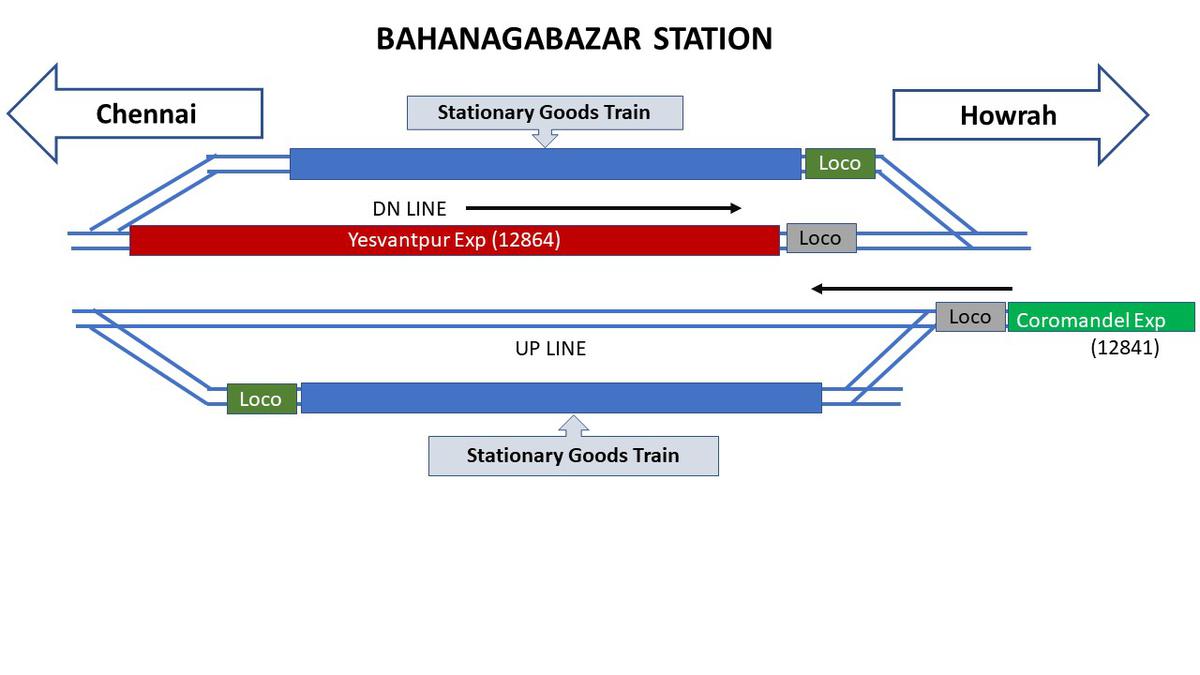The story so far: An electronic track management system used by the railways has become the focus of investigations after last week’s horrific train crash involving two express trains and a goods train in Odisha’s Balasore district that left 275 passengers dead and more than 1,000 injured.
Earlier this week, Minister for Railways Ashwini Vaishnaw told the media that a “change made in the electronic interlocking and point machine” had led to the accident. “The Commissioner of Railway Safety has investigated the matter… we have identified the cause of the incident and people are responsible for it. It happened due to a change in electronic interlocking,” the Minister said, while insisting that the crash isn’t linked to the Kavach anti-collision system.
The Railway Board, the apex body of the Indian Railways, also singled out “signalling interference” in its preliminary probe, with senior officials indicating that possible sabotage and tampering with the interlocking system could have caused the mishap.
What is an interlocking system?
Railway traffic is controlled and managed by railway signaling. Interlocking, an integral part of it, involves a set of apparatus placed on a track to manage the safe movement of trains and track configuration at stations and junctions. It prevents conflicting movements as a train gets a signal to proceed ahead only when its route is set, locked and detected as safe.
The signal apparatus in an interlocking system may be interconnected mechanically or electrically with the tracks or both. Electronic interlocking (EI) is an advanced version of signaling that uses computer-based systems and electronic equipment to control signals, points and level-crossing gates. The Indian Railways defines it as a “microprocessor-based interlocking equipment to read the yard and panel inputs; process them in a ‘fail-safe’ manner and generate required output.” Unlike the conventional relay interlocking system, the “interlocking logic” in an EI system is managed via software and electronic components. It ensures all elements work together in proper sequence so that trains can move without coming in the way of one another.
The three components that form the basis of an electronic interlocking signal system are:
Signals: Based on the status of the track ahead, light signals direct a train to stop (red light), proceed (green), or exercise caution (yellow).
point: These are moveable sections of a track which allow a train to change track by guiding the wheels towards a straight or diverging line. For instance, if a train has to change lines, the point is activated ahead of time and locked. Electric point machines lock and unlock point switches in the desired position.
track circuits: Electrical circuits are installed on tracks to detect the presence of a train between two points. These verify whether it is safe for a train to proceed over it.
Electronic systems, communication devices that control signaling equipment and other components are kept in relay rooms with dual-lock access control. All system activities are recorded in a ‘data logger’, which is similar to the black box of an aircraft.
How does the system work?
The system receives a command, following which information is collected from the yard and processed to set a safe route. The determined route is aligned, and signaling devices are interlocked at a particular position. A signal to pass is given based on which direction the track is set and whether the diverging track is free of obstruction. If a train is required to switch lines, then the system will direct it to the empty track at the point where two lines meet. Track circuits, meanwhile, prevent multiple trains from running on that block to avoid a collision. All points remain locked until the train has crossed a particular section of the track in use or the signal to proceed has been withdrawn. In case there is a failure in the system, the red light will flash, indicating that the route ahead is not clear or safe.
What caused the Odisha crash?
A preliminary probe by Railways officials has found that a problem with the signal system could be the cause of the accident at the Bahanaga Bazar railway station on the evening of June 2. Vaishnaw said that a “change that was done” to the electronic interlocking led the Coromandel Express off the main line and onto the loop line where it crashed into a stationary goods train. In a briefing on the accident, senior Railways officials explained how the accident might have occurred. The Bahanaga Bazar station has four lines — two main lines which are primarily used by trains that don’t have a scheduled stop, and two loop lines for those trains that have to stop or stop at the station.
At the time of the accident, two goods trains were stopped on the two loop lines, while the route was set for two mail express trains that were to pass the station via main lines, as per Railway Board official Jaya Varma Sinha. The route, direction and signal were set.
The Coromandel Express heading south (to Chennai) was given the green signal to enter the Up Main Line. The Yesvantpur-Howrah Express heading north (to Kolkata) was to move on the Down Main Line. At the time of the accident, the Yesvantpur-Howrah was running at a speed of 126 kmph and the Coromandel Express was traveling at 128 kmph — both within the permissible limit of 130 kmph for the section..

As the Coromandel Express was approaching the station, there was a signaling issue, the official said, and the train moved out of the main track and veered onto the adjacent track, the loop line, where it crashed into a parked freight train carrying iron ore , triggering the multi-train collision. The impact of the collision was such that the engine of the Coromandel Express and several coaches jumped the tracks, toppled, and hit the last two coaches of the Yesvantpur-Howrah Express headed in the opposite direction
Did the system malfunction?
Railway officials suspect that there was outside intervention or tampering because the affected stretch was equipped with the “error-proof” EI system which ideally shouldn’t have taken the Coromandel Express to the loop line. Another official told PTI that the kind of tinkering is done with the “logic” of the system can only be “intentional”.
In fact, a senior Railways official had flagged flaws in the signaling system a few months before the Balasore accident. In a letter to his seniors in February regarding a “serious unsafe incident”, the officer raised the issue of trains getting into adjacent lines despite getting the green signal for another track. The official warned that if the signal maintenance system was not monitored and corrected immediately, it would result in serious accidents.
How long is India’s rail track system?
The Indian Railways is the fourth largest railway network in the world under one management, carrying an average of around eight billion passengers annually — earning the sobriquet of ‘lifeline of the nation’. The network is stretched over 68,000 km and comprises more than 7,000 stations with a running track of 1,02,831 km. The total track length, which includes sidings, yards and crossings, stands at 1,28,305 km, as of March 31, 2022.
Over the past decade, the country’s prime transporter shifted focus from obsolete mechanical systems to digital technologies to enhance safety and efficiency, such as modern electronic interlocking signaling systems. According to a statement by the Ministry of Railways, 2,888 stations were provided with electronic interlocking until December 2022, covering over 45% of the Indian Railways. A total of 538 stations were equipped with EI during 2022-23 compared to 421 in 2021-22.
